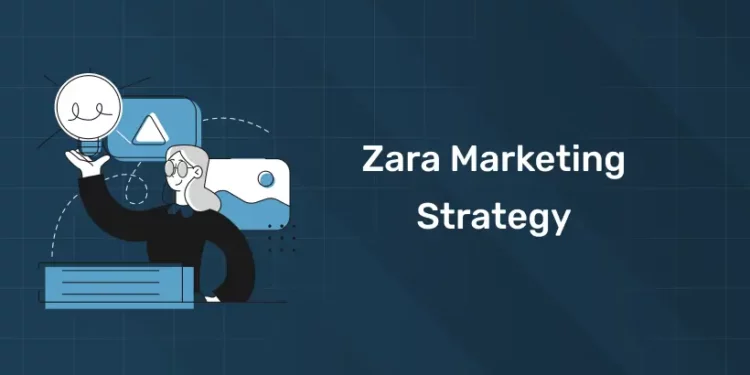Table of Contents
Zara’s Brand Positioning
How Zara Positions Itself as a Fast-Fashion Leader
Zara is a recognized leader in the fast fashion industry, which is impressively known for the opportunity to provide fashionable, affordable clothing at a rapid pace. The marking model lets it react quickly to the latest fashion trends and get new items in the store in a few weeks. While other dealers may take months to publish new collections, the streamlined supply chain and design process of Zara put it before the competition. By continuously updating your inventory and introducing new styles regularly, Zara ensures that customers always find something modern and stylish when shopping. This speed and continuous flow of fresh collection are important for Zara’s success as a leader in a sharp way.
Unique Selling Proposition (USP)
Zara’s unique sales proposal (USP) has the opportunity to give High-Fashion look at cheap prices along with its quick production and distribution models. Unlike the luxury marks that determine the latest trends, but high -value points, Zara makes the similar styles available at a very low price for wider target groups. Another part of Zaras USP is a limited availability of the products. Because the brand produces small amounts of goods, customers know that if they do not buy something they like immediately, next time they travel, go away. It creates a sense of pressure and enthusiasm, and encourages shop owners to make quick purchase decisions.
Brand Perception and Customer Loyalty
Zara is seen as a stylish trendy brand that offers fashionable goods without luxury value. The stores are found in unclear shopping areas, and their modern, minimal appearance provides the brand’s elegant, refined mood. Despite the minimum expenses for traditional advertising, Zara has formed a loyal customer base. People admire the brand to stay up to date on the latest fashion trends and introduce new designs continuously. Zara does not depend on loyalty programs or large discounts for customers to return. Stores often come back because they know something new and fashionable is waiting for them. This stable flow of healthy styles strengthens the customer’s loyalty, as Zara is constantly meeting her fashion needs at cheap prices.
Fast Fashion Business Model
1: What is the primary goal of SEO (Search Engine Optimization)?
Fast fashion is a way to produce clothes quickly and cheaply so the brands can keep the latest trends. This business model focuses on offering trendy clothes to customers in a short time, often a few weeks. Fast fashion companies produce large amounts of low prize products, making people easier to buy and use the latest styles without spending too much money. However, this approach has faced criticism because of the impact on the environment and workers in the supply chain.
Zara’s Approach to Fast Fashion
Zara, a Spanish drug brand, is one of the world’s most famous fast fashion companies. It has succeeded in following a quick fashion model that allows it to get new styles in the store very quickly. Zara does not follow the traditional fashion calendar, which usually consists of just a few large seasonal collections. Instead, Zara produces new styles continuously throughout the year, making it easier for customers to find fresh designs in stores.
Zara’s design team closely monitors fashion trends, street style and customer preferences. They quickly convert this insight into new clothing designs, which occur within a few days or weeks. This allows Zara to be ahead of the competition and answer what customers want in real time.
Quick Turnaround from Design to Stores
One of the principle functions of fast fashion is the possibility to convey new designs fast to the shop, and Zara is a leader in it. While traditional fashion brands can take several months to create a brand new collection, Zara can move from designing a brand new item, that can lessen it in stores with the aid of to four weeks. This is made possible by using efficient supply chain and production tactics for instant turnaround Zara.
Zara’s factories are located close to the headquarters in Spain, which helps to speed up the manufacturing technique. By keeping maximum of the production local, Zara can produce and ship new styles to save all over the global, that’s a whole lot quicker than different manufacturers that depend on factories in remote international locations.
Limited Edition Collections to Drive Demand
Another important factor of Zara’s quick fashion version is the use of restrained version collection. Zara produces small parties with new designs, which means that that once a selected style is sold, it can’t be carried out once more. This creates a experience of craving for clients to buy goods quick because they recognise they’ll now not have the ability to shop for them later.
Limited accessibility strategy requires driving force when people feel pressure to buy new goods before disappearing from stores. It also helps Zara to avoid having a large amount of unusual warehouse, which can be expensive for retailers.
Become an AI-powered Digital Marketing Expert
Master AI-Driven Digital Marketing: Learn Core Skills and Tools to Lead the Industry!
Explore CourseDigital & Social Media Marketing
It is a process of marketing products or services using online platforms such as digital and social media marketing Instagram, Facebook and Tikok. These platforms allow companies to join large viewers by sharing material such as photos, videos and ads.
This type of advertising could be very popular because it is value -effective, easy to song, and may attain a big range of people right away.
Companies use social media platforms to market their merchandise, get in contact with clients and create brand cognizance. There are different ways for digital marketing, including the paid advertising campaign, collaborating with those affected or using minimum advertising strategies.
1. Instagram, Facebook, TikTok Campaigns
Social media campaign on platforms such as Instagram, Facebook and Tiktok is a popular way of reaching the target groups for companies. These campaigns usually include eye -catching posts, videos or stories that highlight a product or service.
- On Instagram, for example, companies can share high quality images, use hashtags and post stories to contact users. They can also run paid ads that appear in users’ feeds and ensure their content reaches more people.
- Facebook campaign often uses combinations of photos, videos and targeted ads. Facebook has a lot of information about their users, so companies can create very targeted ads based on age, location, interest and behavior.
- A video sharing platform has become a prominent player in social media marketing, especially among the young audience. TIKTOKS algorithm helps the material to become viral, so a well -done campaign can reach millions of people in a very short time.
2. Influencer Collaborations
Impressive collaboration is another popular strategy in digital marketing. Influencers are with a big people on social media who can promote a product or service to the public. Many companies work together with influential as their followers depend on their opinion and recommendations. For example, a fashion mark can send clothes to a popular Instagram affected, which then posts pictures of themselves wearing clothes. Such promotion seems more individual and authentic than traditional ads.
3. Minimal Advertising Strategy
A minimum advertising strategy means that a business instead of spending too much money on ads, focuses on organic development through word mouth, engagement on social media and quality material. This approach depends on continuously laying out valuable materials, interacting with followers and creating a strong brand appearance by creating a loyal customer base without relying heavily on the paid ads.
- For example, a small company can focus on posting high quality materials on Instagram and associated with the audience through comments and messages.
- By creating a community around your brand, they can attract more customers over time without spending too much money on advertising.
Learn Digital Marketing Fundamentals! Get Free Demo Here!
Customer Engagement & Shopping Experience
One of the world’s most successful fast fashion brands, Zara has developed a sophisticated approach to confuse both in the store and online. By integrating digital technologies, by customizing the purchasing experience through their app, and using data analysis and AI, Zara has created a very efficient and customer -focused shopping environment.
Zara’s In-Store Experience and Digital Integration
- Zara’s experience in the store is designed to be simple, stylish and user -friendly.
- The stores are located in a minimal way, with pure performances that make it easier for customers to browse through the latest collections.
- Zara frequently updates designs in the shop and product exhibitions to reflect the present day style traits, main to a brand new experience for clients with each journey. This dynamic format encourages repeated journeys, as clients know that they may always discover some thing new and exciting.
- One of Zara’s maximum essential techniques for growing the experience in the shop is to integrate virtual technologies.
- In addition, Zara has offered cellular charge options, in which customers can pay at once from their smartphones using the Zara app, similarly checkout.
Personalized Shopping Through the Zara App
The Zara app performs a key function in growing a personal purchasing enjoy for customers. Using the app, customers can browse the latest collections, take a look at the availability of the product of their nearest store and shop from the telephone. One of the primary capabilities of the app is its personal pointers, based totally on the patron’s previous purchase and surf history. This approach that every time a customer logs on to the app, they observe products that healthy their alternatives and taste, main to extra sewn purchasing.
The Zara app also makes shopping in the store less difficult by way of offering features which includes barcation scanning. If a purchaser finds an item in the store, they can scan the barcode with the app to see in addition details, including size tops, purchaser critiques or styling tips. This gives more records about the client’s arms, which reduces the want to depend on the store staff for assist.
Use of AI and Data Analytics
The use of artificial intelligence (AI) and information evaluation of Zara plays an important position in improving each consumer engagement and standard shopping enjoy. Zara collects records from her on-line platforms and bodily stores to better recognize the patron’s behavior, possibilities and purchase styles. This facts enables Zara make informed selections that products layout, produce and stock of their stores.
Data analysis additionally facilitates Zara to streamline the deliver chain and ensure that the goods move speedy from the manufacturing facility to the store. By the use of AI to are expecting traits and control stock, Zara can repair a short commodity and respond extra efficiently to the consumer.
Pricing & Product Strategy
Zara has created the success of a unique price and product strategy that combines strength with a sense of uniqueness. This approach ensures that customers are constantly engaged and feel motivated to act quickly. The most important components of Zara’s strategy are its affordable price models and frequent product rotation with limited shares, both of which work together to increase demand and increase customer loyalty.
Affordable Pricing Model
Zara follows a reasonable pricing strategy, accessible to a wide range of customers, and offers fashionable and fashionable clothing at these prices. By producing clothing in early and high versions, Zara can keep costs low, and maintain a sense of style and quality that appeals to fashion -conscious store owners. This pricing model is important for the sharp fashion concept of the brand, as it allows Zara to compete with other high -road retailers, while still attracting a comprehensive customer base.
Although the Zara prices are lower than many luxury brands, the company is capable of balance between strength and perceived price. Zara uses high quality clothing, keeps the design similar to the latest trends and maintains a premium store environment, which all contributes to the assumption that customers get fashionable substances at a reasonable price.
Product Rotation and Limited Stock to Create Urgency
A significant portion of Zara’s product strategy is the frequent product rotation and limited share accessibility. Zara introduces new styles in the store every two to fourth weeks, compared to traditional retailers. By constantly updating your list of fresh designs, Zara creates a sense of readiness to buy immediately for customers, as goods may not be available in a long time.
In addition, Zara produces limited amounts of the collection, which strengthens this urgent. When an item is sold, it rarely restores, and pushes customers to make quick purchase decisions for fear of disappearing from the latest trends. This strategy also reduces further inventory, and ensures that Zara does not need to rely too much on sales or exemption to clean the unusual stock.
Become an AI-powered Digital Marketing Expert
Master AI-Driven Digital Marketing: Learn Core Skills and Tools to Lead the Industry!
Explore CourseSupply Chain & Sustainability Efforts
Zara’s success in the rapid fashion industry is not just a result of its fashionable design and reasonable prices, it is also a very effective supply chain. At the same time, Zara tries to raise questions about stability, balancing the need for rapid production with environmentally friendly practice. This combination of effective supply chain management and increasing focus on stability is a significant impact on the notion of the brand among customers.
Efficient Supply Chain Strategy
Zara has created an incredibly efficient supply chain that lets it store it in just two to four weeks. This rapid treatment time is one of Zara’s main causes in fashion rapid fashion. Most of Zara’s factories are located near the headquarters in Spain, giving the company better control over the production process. By keeping most of the construction closer to the house, Zara can quickly respond to changed trends and customer preferences.
Sustainability Initiatives and Eco-Friendly Production
Despite its sharp fashion models, Zara has taken steps to improve stability efforts. The enterprise has served to apply more environmentally friendly materials, lessen water use and decrease carbon emissions.
Zara has also applied environmentally friendly manufacturing strategies in some factories, together with the use of renewable electricity and promoting green water and power use throughout manufacturing. In addition, the brand has launched garb recycling packages in stores, urging clients to go back old clothes for recycling or donation.
Impact on Brand Perception
While Zara has been criticized for contributing to rapid fashion -related environmental problems, recent stability efforts have helped improve the brand image. Many customers appreciate the company’s footsteps to reduce the environmental footprint, especially in the industry known for waste and overflow. By actively promoting their environmentally friendly initiatives and making progress to the stability goals, Zara works for a more responsible and environmentally conscious brand.
Learn Digital Marketing Fundamentals! Get Free Demo Here!
Competitor Analysis
1. Comparison with H&M, Uniqlo, and Shein
Zara works in a very competitive fast fashion market, with large rivals such as H&M, Uniclow and Shin. Each brand follows separate business models, with separate marketing, branding and product strategies.
I) Zara vs. H&M
- H&M focuses on offering a variety of clothes, including the basic, contingent wear and even collaboration with high end designers such as Carl Larmfeld and Balman. On the other hand, Zara updates herself as a trend -driven brand, updates the collection every other to fourth weeks to reflect the latest fashion styles.
- Zara depends a lot on minimal advertising, focuses on Prime Stores locations and creates one in the store and an innate shopping experience. On the contrary, H&M, on the contrary, invests more in marketing campaigns, celebrities and ads on social media to reach wide target groups.
II) Zara vs. Uniqlo
- A Japanese brand is quite different in fashion approaches from both Uniclo, Zara and H&M. While Zara is trend -driven, Uniclow focuses on timeless, minimum design etc.
- Uniqlo’s main strategy rotates to create functional, comfortable clothing that can be used years. On the other hand, Zara follows, quickly fashion trends and regularly rotates its product lines, and produces urban customers with limited-Setskrit collections.
III) Zara vs. Shein
- Shein, a Chinese-primarily based on line store, has emerged as a strong competitor inside the fast style market because of its ultra-less expensive pricing and huge on-line presence.
- Shein is understood for presenting an great choice of extremely cheap apparel, with thousands of recent patterns delivered to its internet site each day. Zara, whilst less expensive, is positioned as more top rate in comparison to Shein and locations extra emphasis on fashion and nice.
- Shein brand is exceptionally lively on platforms like Instagram, TikTok, and YouTube, often working with micro-influencers to sell its merchandise. Zara, by using evaluation, makes use of minimal advertising and marketing and relies greater on phrase-of-mouth, its strong brand presence, and the general shopping revel in to drive purchaser engagement.
Key Differences in Marketing and Branding Strategies
Marketing:
- Zara: Minimum advertising focuses on Prime Large Locations and Digital Integration (eg Zara App, promoted reality in the store).
- H&M: Investment in celebrity approval, collaboration with advanced designers and frequent ads on social media.
- Uniqlo: The product focuses on profits and functional designs, and postpones innovations such as Heattech and Airism.
- Shein: Digital marketing, especially social media, heavy dependence on Flash sales to draw attention.
Branding Strategies:
- Zara: Trend-driven and fashion-front, a cheap, yet distributed as a first-class fast fashion.
- H&M: Objectives for broad appeal, strength and environmentalism with a mixture of trend -centric fashion and durable alternatives.
- Uniqlo: Focus on timeless, functional and basic and high quality basics, appeals to customers who prefer comfort and practically on trends.
- Shein: Ultra-digit, trend-centric and focus on focus on access to large-scale, large-scale appeal and young, budget-conscious consumers.
Case Study: Successful Zara Campaign
One of Zara’s most successful marketing initiatives was the “Dear South Africa” campaign, which was launched in 2015 when the brand opened its first store in Johannesburg. The campaign demonstrated how Zara uses minimal advertising, but still creates a strong impact by matching local culture and taking advantage of social media -surr, major effects and brand loyalty.
Campaign Overview
Zara’s entry into the South African market was very awaited, as fashion enthusiasts in the region were already familiar with the brand, thanks to Zara’s strong international appearance. The “Dear South Africa” campaign was mainly focused on creating enthusiasm through social media and Word-off-mouth, combined with a smooth, in the store combined with Zara’s global brand identity.
In the leading weeks of store launch, Zara used its digital platforms, such as Instagram and Twitter, used to tease the first date and share the contents of the store back and forth. South Africa’s affected, fashion bloggers and media personalities were invited to exclusive events before opening, where they could preview stores and collections. These affected then shared their experiences on social media, which led to discussion and expectations among their followers.
What Made It Work?
-
Minimal yet Effective Advertising: Zara’s approach not to rely too much on traditional advertising channels worked when it used the already strong brand.
-
Local Influence: The campaign was successful when it accepted culture and fashion sensations in the local market, which made South African customers feel that Zara was actually invested in the market.
-
Influencer Power: By incorporating large South African affected and fashion bloggers into exclusive events, Zara used the power of impressive marketing to reach wide target groups.
-
Creating Anticipation: A slow build -up on social media, led to store launch, made an aura of uniqueness and expectation, drive more toe traffic to opening day and expanded online engagement.
Conclusion
Zara’s marketing strategy is a unique combination of minimal advertising, trend -centered products and a better customer experience. Instead of relying on major traditional advertising campaigns, Zara creates enthusiasm and demand through word-off-mouth, Prime Store locations and a spontaneous shopping experience that blends physical and digital elements. This approach allows Zara to maintain specificity and premium branding, offering cheap, fashionable fashion.
Overall, Zara’s marketing strategy is designed to generate great demand with minimal traditional advertising, and a strong customer experience that feels personal and premium. These elements have helped the brand become a global leader in a fast manner, while innovation continues in response to the dynamics of the changed market.
| Related Links | |
| Red Bull Marketing Strategy | Samsung Marketing Strategy |
| Starbucks Marketting Strategy | Adidas Marketing Strategy |
Frequently Asked Questions
What type of marketing does Zara use?
What makes Zara unique?
What is Zara brand identity?
The personality element in the Zara brand considers the customer as a brand that is a person that forms products that reflect self -confidence, maturity, style, aggressive and origin










